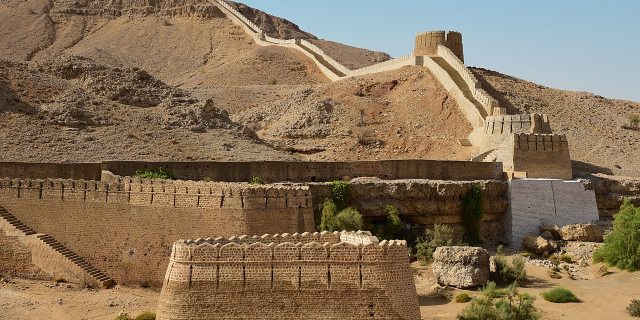Shah Jahan Mosque, Thatta
The Shah Jahan Mosque (Urdu: شاہ جہاں مسجد, Sindhi: مسجد شاهجهاني،, Persian: مسجد شاهجهان), also known as the Jamia Masjid of Thatta (Urdu: جامع مسجد ٹھٹہ, Sindhi: شاھجھاني مسجد ٺٽو), is a 17th-century building that serves as the central mosque for the city of Thatta, in the Pakistani province of Sindh. The mosque is considered to have the most elaborate display of tile work in South Asia, and is also notable for its geometric brick work - a decorative element that is unusual for Mughal-period mosques. It was built during the reign of Mughal emperor Shah Jahan, who bestowed it to the city as a token of gratitude, and is heavily influenced by Central Asian architecture - a reflection of Shah Jahan's campaigns near Samarkand shor...Read more
The Shah Jahan Mosque (Urdu: شاہ جہاں مسجد, Sindhi: مسجد شاهجهاني،, Persian: مسجد شاهجهان), also known as the Jamia Masjid of Thatta (Urdu: جامع مسجد ٹھٹہ, Sindhi: شاھجھاني مسجد ٺٽو), is a 17th-century building that serves as the central mosque for the city of Thatta, in the Pakistani province of Sindh. The mosque is considered to have the most elaborate display of tile work in South Asia, and is also notable for its geometric brick work - a decorative element that is unusual for Mughal-period mosques. It was built during the reign of Mughal emperor Shah Jahan, who bestowed it to the city as a token of gratitude, and is heavily influenced by Central Asian architecture - a reflection of Shah Jahan's campaigns near Samarkand shortly before the mosque was designed.
 The entry way to the main prayer hall is from the central courtyard.
The entry way to the main prayer hall is from the central courtyard.Persian inscriptions at the mosque indicated that it was built between 1644 and 1647,[1] during the reign of Mughal Emperor Shah Jahan. An eastern addition was completed in 1659,[2] during the reign of Emperor Aurangzeb.
The mosque's mihrab had initially been incorrectly aligned with Mecca. The Sufi mystic, Makhdum Nooh, who is buried in the nearby city of Hala is said to have been approached by the mosque's planners in order to correct its alignment. Popular tradition maintains that Makhdum Nooh then corrected the error overnight by the power of his prayer, thereby ensuring his status as a saint.[3] Historical records show that the mosque's mihrab had actually been rebuilt a century after the mosque's construction.[3]































Add new comment